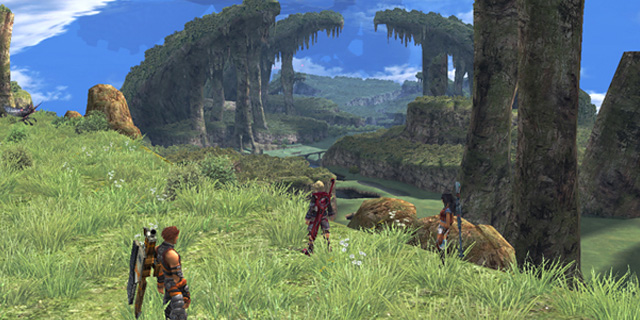
How do you evolve a genre that has remained consistent for as long as it has existed without alienating fans? Japanese RPGs have grown in terms of quality and scale, sure, but they all follow a very basic formula and rarely do they deviate from it. Xenoblade Chronicles changes all of that. By taking a few pages from the Western RPG playbook and giving them a JRPG spin, it manages to take a genre and push it out of its comfort zone. The results are simply spectacular.
The story is pretty grand and paced excellently, allowing you to follow it at your own pace while still giving the player plenty of time to explore. It takes place on the body of a giant known as the Bionis, who was once in great battle with another giant, the Mechonis. It’s been centuries since the grand battle, and now people known as Homs inhabit the Bionis. The game follows Shulk, a young Homs who is thrown into a conflict between the people of Bionis and the Mechons from Mechonis that he himself doesn’t fully understand. Eventually he comes across a weapon of mysterious power known as Monado, which sets him off on his journey to stop the Mechons and discover the truth about the blade. The story goes in plenty of interesting directions and it never feels dull; having a large, likeable cast of characters helps.
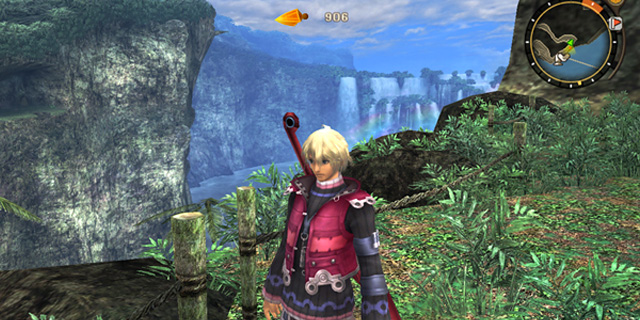
You’ll be surprised just how much the development team can do with the limited Wii hardware. The folks at Monolith Soft clearly paid a great amount of attention to the level of detail in the game. From the gorgeous environments to the always brilliant soundtrack, there is never a dull moment in this game’s presentation. The voice cast seemed a little off to me at first, but it grew on me as the game goes on, with certain characters pulling in surprisingly powerful performances by the end.
Once you get going, you are free to explore this open world as you please, talking to people and accepting some of the game’s many side quests. The amount of things to do in this game rivals even that of Skyrim’s side content, although the level of complexity is not quite there. Many of the side quests follow pretty similar patterns: killing a certain number of enemies, collecting a certain number of materials, killing monsters unique to that area. There are others that keep things from seeming too same-y, but they all generally follow that pattern. The quests can get a bit tedious, but you never have to make them your main focus. Outside of certain timed quests, the game always lets you come back to them whenever you want.
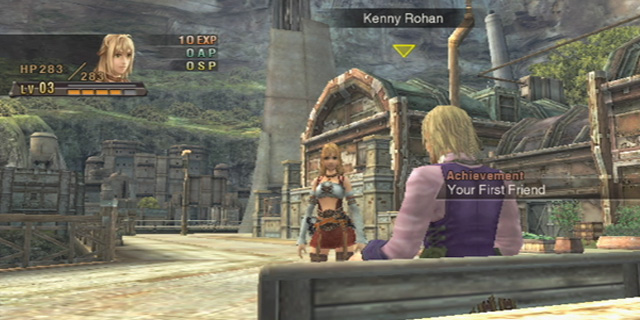
The best part about the side quests is how you almost never have to return to the quest giver in order to complete it. You kill a certain number of enemies? Quest complete, and you get your reward right then and there. This cuts down on a lot of the tedium and saves you a ton of backtracking. Outside of that, there is also a day and night cycle that keeps you on your toes. In some areas, certain monsters will only appear during certain times of the day as well as certain NPCs; thankfully, you can change the time of day on the fly, which also inevitably saves the player a lot of time in the long run.
The battle system is very reminiscent of Final Fantasy XII, at least in terms of the basic mechanics. Each area you’re in is full of plenty of monsters to kill. Fighting them doesn’t load to a new battle screen, simply taking place right there where you initiated the fight. You also have an auto-attack, which will allow you to continue pummeling the enemy while focusing on what moves to use next. Each character has their own set of specific moves that you can choose from, making them all play differently.
During battles, you are able to see just what each move available to you does, allowing you to plan your strategy well. Some attacks work better when attacked from the back, some are meant to be used when the enemy is stunned and some are support moves that help your own character or your fellow party members. The number of different moves and possible combinations of attack are pretty lengthy; it won’t be long before you find a character and a set of moves that work best for your play style. The battle system can be complex if you allow it to be, but it never feels overwhelming, as you always know when you learn a new ability and exactly what it does. And even if you don’t, the game is forgiving enough and always allows you to try out new strategies.
The best part about Xenoblade Chronicles is just how much the little touches help. During battles, whenever a status effect is afflicted, you can press a button to see exactly what it is and what it does at any time. If you happen to lose a battle, it starts you back at the last landmark you passed, which is essentially a checkpoint in the game’s open environments. Even during bosses, you simply go back to the last landmark and can choose to either level up or run and fight it again right away.
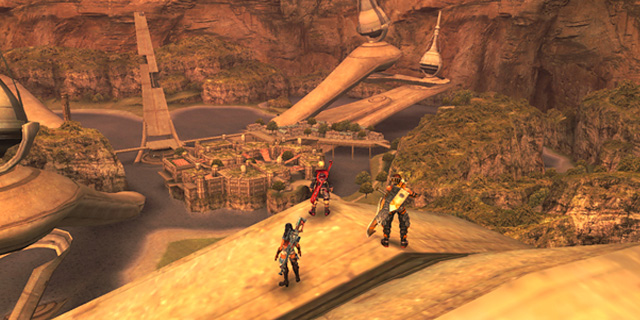
These changes also make traveling super simple. Find a fence that you think you can jump over? You probably can. Want to swim around an environment to fill out the entire map? Go for it. Want to go back to a previous landmark from the beginning of the game? Go right ahead. Besides being a checkpoint, each landmark is also a handy fast-travel point that allows you to quickly go from area to area. Combine that with the fact that you can save whenever you want, and you have a game that can work for either shorter or longer play sessions. These are things that we almost never see in JRPGs, and Xenoblade pulls them all off spectacularly.
You also have the ability to craft gems, which you insert into equipment. These gems are like the accessories of the game, either increasing specific attributes or doing things like blocking status effects. You will often receive gems from collecting items, looting treasure chests, or completing side quests, but you’ll also find plenty of materials around the world that you can use to craft your own gems. The crafting system is as basic as it gets, but it works just well enough that you’ll always want to come back to it.
The one small problem I found when dealing with gems is how it can make inventory management a bit of a hassle. If you have gems equipped to specific weapons or pieces of armor, you will have to unequip them every time you want to equip new armor or weapons. This also makes comparing weapons and armor a bit of a pain when deciding on what to buy. I often found myself running into this problem to the point where I didn’t look forward to purchasing or finding new equipment.
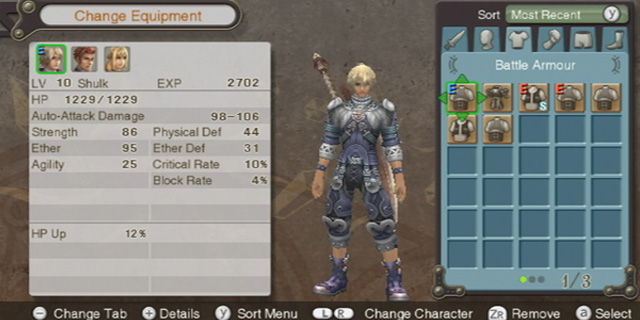
For example, when you go to buy a new weapon, you’ll see how it compares to the old weapon for a character. But it doesn’t take into account that specific gems are equipped, so it might show that certain statistics decrease when the gems are removed. You will have to know which gems you have equipped at all times so you know when a weapon is actually weaker than the one you have, or is only weaker because it doesn’t currently have those gems equipped. It makes the process more cumbersome than it needs to be, especially when gems seem like such a huge part of the game.
Small complaints aside, Xenoblade Chronicles does a lot right. It evolves this style of game by taking the necessary steps forward to keep things fresh, while respecting what made the genre so popular in the first place. It will appease both RPG veterans and newcomers alike, proving to everyone that there is a lot more life left in the JRPG genre.
Pros: Sweeping storyline, likeable characters, addictive battle system, plenty of side content, brilliant presentation
Cons: Poor inventory management, side quests can get tedious



















